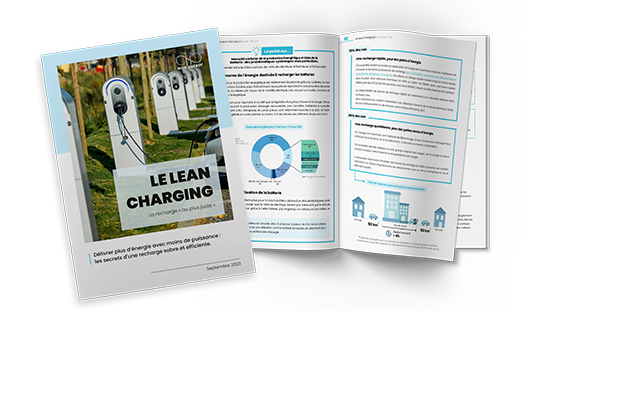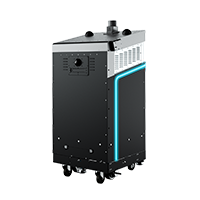Smart Charging: what you need to know
In France, almost one in five vehicles sold is now electric or a rechargeable hybrid. Recharging is therefore a major challenge for the energy transition and for all those involved in mobility, from car fleets to public car parks.
But it’s also a technical challenge, because to recharge all these electric vehicles, you need power. Power that is not necessarily available everywhere, because of the technical constraints of the building, or the limits and difficulties of connection, and at all times, depending on the availability of the electricity network and any peaks in consumption.
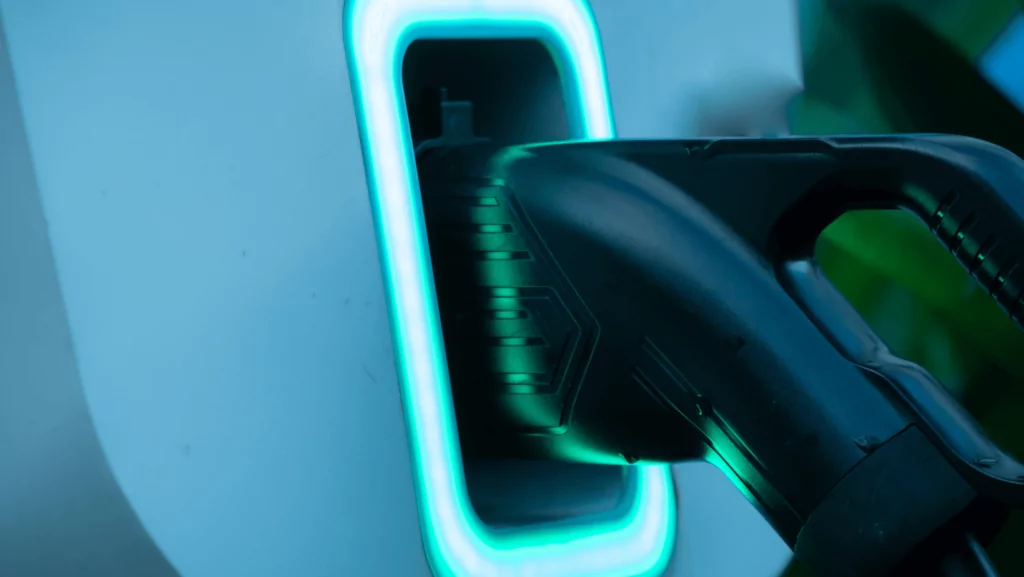
Faced with this problem, a number of innovative recharging solutions have been developed, such as smart charging, an innovative solution for efficiently managing the recharging of electric vehicles according to different criteria.
What is smart charging?
In practical terms, this is a sophisticated energy management system thatoptimises charging by taking various parameters into account. Thanks to cutting-edge algorithms, smart charging is able to communicate in real timewith electric vehicles, charging points and electricity networks to adjust charging according to users’ needs, electricity network constraints and energy pricing conditions.
Intelligent charging involves planning and controlling charging according to a number of parameters, such as energy availability, battery capacity, charging time, the number of vehicles connected and the cost of electricity. Thanks to this technology, electromobilists can benefit from faster, more efficient recharging, as it will be adapted to their parking time, while avoiding overloading the electricity network.
Automated management of the recharging service
With the introduction of smart charging, the distribution of energy between the charging points is no longer fixed, but varies automatically. For example, the algorithm will adjust the capacity of each charging point according to the expected demand for charging at each location.
It is also possible to regulate charging demand by using technologies that help to avoid peaks in consumption. Here are three examples of ways of regulating charging demand:
- Network service contracts encourage drivers to recharge during off-peak hours by offering advantageous tariffs.
- Charging management systems automatically adjust the power of each charging station according to the availability of the electricity network, to smooth out energy demand.
- Communication technologies, such as mobile applications or smart charging points, inform drivers of charging rates in real time to encourage them to charge their vehicles during off-peak hours.
Lastly, the interoperability or connectivity technologies used for charging stations enable activity to be monitored and invoicing to be automated, thereby optimising the operating cost of the infrastructure. Thanks to these technologies, collecting information on the energy needs of service users paves the way for dynamic adaptation of the offering.
Advantages of smart charging for businesses and recharging operators
Smart charging is an intelligent recharging solution that offers a number of advantages, both for companies electrifying their fleets and for recharging operators.
- Smart charging reduces costs by optimising the charging of electric vehicles according to energy demand. Businesses can avoid electricity demand peaks and overloads that lead to additional costs.
- Intelligent recharging reduces recharging infrastructure costs by optimising the use of recharging points and reducing the investment needed to increase recharging capacity.
- By simplifying the installation of charge points, smart charging solutions are also helping players to roll out their IRVEs and meet their legal obligations, such as those under the LOM law.
- Smart charging also makes it possible to optimise the management of electric vehicle charging by avoiding high energy demands. Companies can programme the charging of electric vehicles to take place outside peak hours, when demand for electricity is lower.
- It contributes to the energy transition by reducing the carbon footprint of businesses. By using renewable energy sources to store energy and recharge electric vehicles, businesses can reduce their environmental impact.
The different levels of smart charging optimisation
The installation of charging points for electric vehicles has become a major concern for many businesses, which are keen to reduce their carbon footprint and meet regulatory requirements. However, the costs associated with allocating power are considerable, and charging points are often underused.
All of which means that we need to take an interest in the adoption of smart charging. The term “smart charging” actually covers several techniques and levels of optimisation, ranging from power management to demand management and monetisation.
Increasingly sophisticated, each level of optimisation offers solutions to improve power management, user experience or costs, on a greater or lesser scale.
Level 1: Dynamic Load Management (DLM)
Dynamic Load Management aims to optimise the use of charging points while reducing costs. This approach consists of limiting the power demand by sharing the total power allocation between several charging points.
For example, if 20 22 kW load points are installed, rather than allocating the maximum power (440 kW), we could install a maximum power of only 100 kW, and share it between the 20 load points. They could then all be activated simultaneously at 5 kW, or only 10 at 10 kW, or even 5 at 20 kW. The distribution of power between the charging points depends on requirements (number of electric cars connected simultaneously) and the capacity of each electric vehicle in terms of charging speed.
This dynamic load management solution can be extended to include a variety of settings, such as limiting the energy delivered during times when energy availability is a problem.
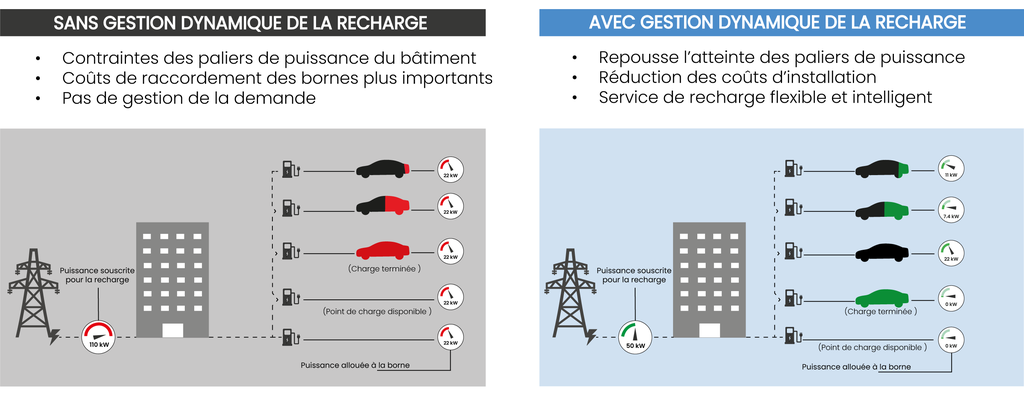
Level 2: DLM and scheduling
Implementing Dynamic Load Management (DLM) is an important first step in optimising charging. However, this method does not solve the whole problem, because all the charging points are connected to the network. As a result, the end customer is not always informed of this optimisation (“I thought I had 22 kW, but I only have 7.4 kW…”).
To improve efficiency, prioritisation or scheduling systems are needed. These involve polling users to determine their energy requirements, departure times and the types of vehicle used. A scheduling algorithm is then used to distribute the energy available at the charging points according to user requests.
These prioritisation systems are not yet widespread, due to the complexity of integrating them and the variety of existing systems and charging points. Nevertheless, the use of these technologies is an important way of improving the efficiency of smart charging and offering a more satisfactory user experience.

Level 3: interconnection
By combining DLM and scheduling, we have begun to optimise the allocation of power required to operate the charging service, as well as the experience of users of this service. However, the impact of these optimisations remains limited and the costs in terms of cabling and connecting the charging points are still substantial. The combination of systems is relatively inflexible and will be limited fairly quickly as user demand grows.
The idea of interconnecting chargepoints offers a response to this need for scalability. The idea is to use chargepoints that can be added to gradually, simply and quickly, like Lego pieces. Instead of connecting all the chargepoints individually to the network, a single large cable is connected to the network and each chargepoint is linked to it.
Although this solution may seem simple on the surface, the interconnection concept requires energy to be moved along several cables, which is a technical challenge. However, this solution allows the infrastructure to evolve as needs and demand change, relatively simply and at a lower cost, while using the smart charging concepts described above: DLM and Scheduling.
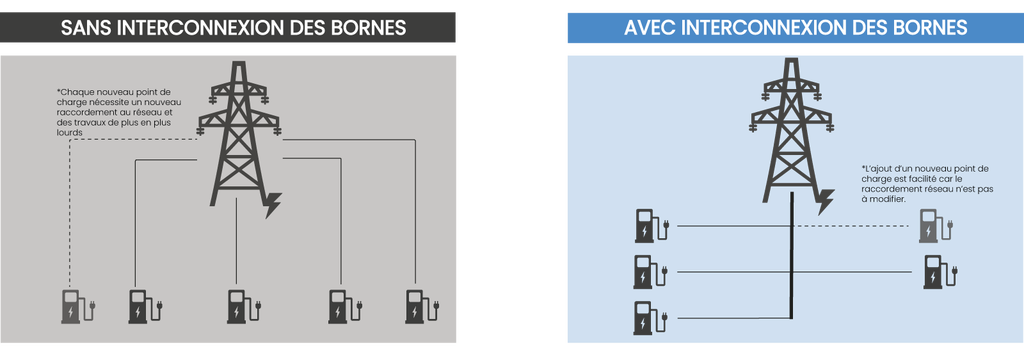
Level 4: Storing and boosting the network to smooth out and increase flexibility
Despite the progress made in optimising their charging points, charging point operators are faced with limitations. Input power may be one of them, as each chargepoint cannot deliver more than this limit. If the available input power cannot exceed 220 kW, the 20 charging points will never be able to deliver more than 11 kW simultaneously, even if the infrastructure uses DLM, scheduling and interconnection techniques.
To overcome these limitations, storage batteries can be used to smooth out instantaneous energy requirements and optimise the use of available power. By storing energy during periods of low use, the battery can supply additional energy when demand is high, increasing the flexibility of the system.
The addition of converters can transform the energy stored in the battery into additional power to boost the available input power. So, even if the grid only supplies 10 kW, the battery and its converters can provide up to 60 kW of charging power, making for a faster, more efficient service.
The installation of batteries and converters obviously comes at a cost, but the solution also makes it possible to allocate less power, store energy at off-peak times, benefit from surplus photovoltaic energy production, and offer a much better quality of service. Overall improvements that make all the difference when you consider the total cost of the solutions (TCO) over their entire lifetime.
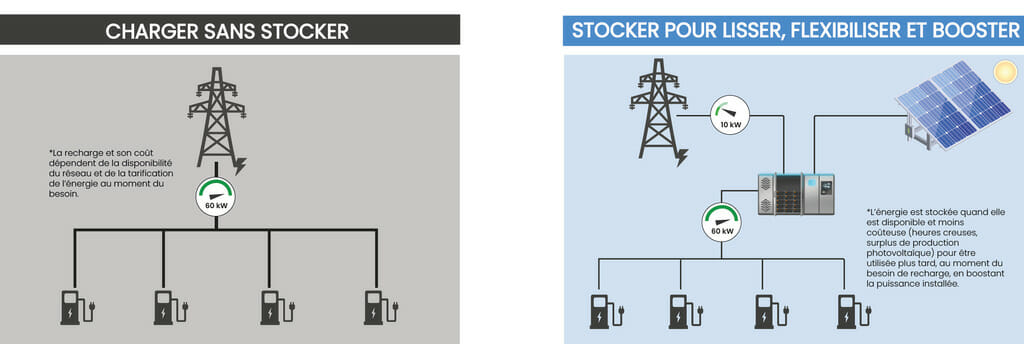
The integration of all smart charging techniques in a single solution: EIKO
The EIKO power cube is an innovative, scalable solution that incorporates all the improvements and techniques described above. It consists of an interconnected system of charge points, controlled according to user demand, and coupled with second-life batteries that store energy to boost the power available on the grid.
- With a single cable connected to the low-power grid, EIKO makes it possible to electrify several charge points simultaneously.
- The chargepoints are connected to Eiko, but not to the network, offering great flexibility by allowing new chargepoints to be added without additional work, for up to 20 chargepoints.
- Highly scalable in terms of the number of charge points, Eiko is also scalable in terms of energy storage, from 50 kWh to 150 kWh, and in terms of charging modes, making it possible to unlock DC fast charging in two places.
- The second-life batteries used will enable the IRVE project to take an even more responsible approach, by extending the useful life of car batteries, and thus optimising the carbon footprint of their production.
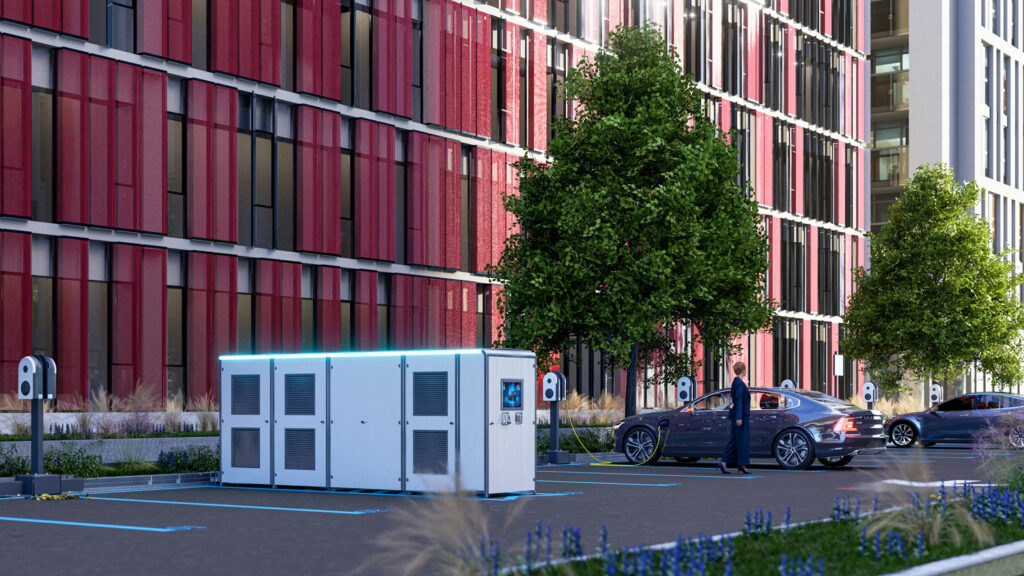
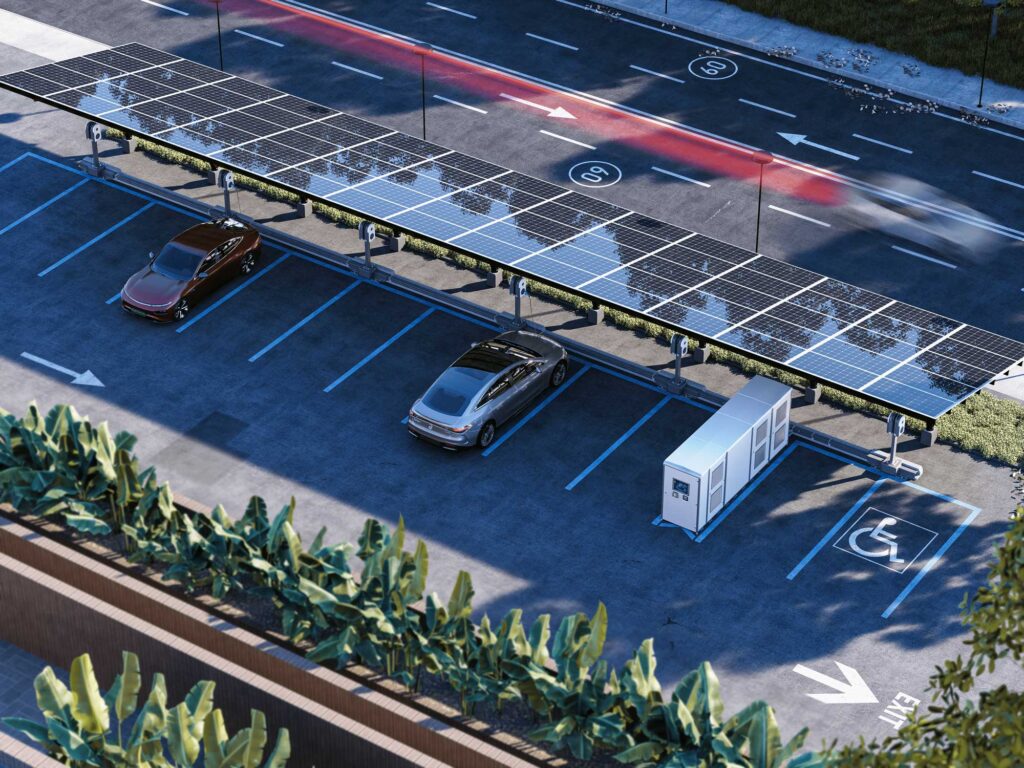
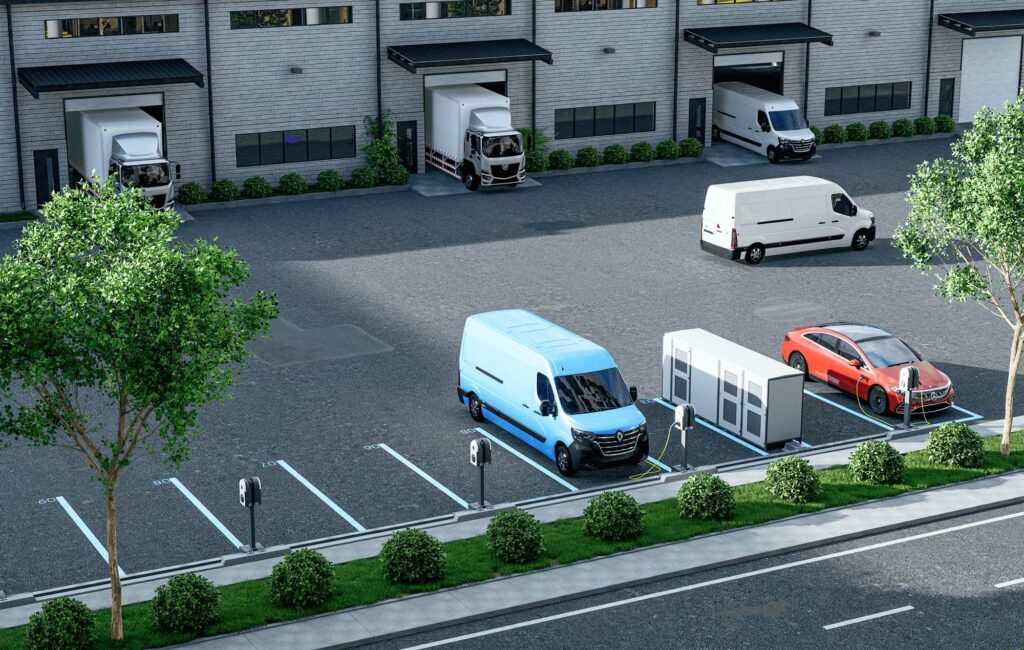
Mob-Energy invites you to explore ways of intensifying the use of resources available for recharging. The challenge: to meet the challenges posed by a power shortage that is under-utilized and costly to install.
Feel free to download our new white paper!
